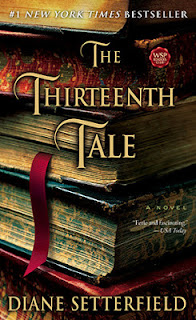The Thirteenth Tale
Summary (from the publisher): Reclusive author Vida Winter, famous for her collection of twelve enchanting stories, has spent the past six decades penning a series of alternate lives for herself. Now old and ailing, she is ready to reveal the truth about her extraordinary existence and the violent and tragic past she has kept secret for so long.
Calling on Margaret Lea, a young biographer troubled by her own painful history, Vida disinters the life she meant to bury for good. Margaret is mesmerized by the author’s tale of gothic strangeness—featuring the beautiful and willful Isabelle, the feral twins Adeline and Emmeline, a ghost, a governess, a topiary garden and a devastating fire.
Together, Margaret and Vida confront the ghosts that have haunted them while becoming, finally, transformed by the truth themselves.
Review: The Thirteenth Tale is told from the perspective of book lover and budding writer Margaret Lea, who has been asked by famous but mysterious author Vida Winter, who on her deathbed has decided to reveal the true story of her life. Vida's story is one of generations of neglect and a dysfunctional who lives in the crumbling house Angelfield, and about twin girls, Adeline & Emmeline, running wild and unsupervised.
Two large themes of this novel are reading and twins. Margaret's father owns a rare book shop and the library at Angelfield is frequently mentioned. Jane Eyre is a frequently mentioned book, loved by both Margaret and Vida. However, some of the many passages describing her love for reading felt forced to me. It's not the physical act of reading that readers love, its the story, the journey. The many descriptions of Margaret reading sort of dragged to me. Margaret and Vida also have twins in common. Margaret was born a conjoined twin, but her twin died when they were separated. Vida's tale reveals the story of twin girls Adeline and Emmeline. The historical fiction and gothic aspects of this novel reminded me greatly of Kate Morton's novels. On the other hand, the continual references to ghosts and twins reminded me of Audrey Niffenegger's Her Fearful Symmetry.
A lot of this novel failed to ring true for me. Why would such a famous author randomly select an unknown girl to write her story? If Winter legally changed her name, why would there not be a paper trail leading back to her childhood? Why did everyone allow the neglect and child abuse continue at the Angelfield home? How did Vida survive financially after Angelfield burned and she struck it out alone?
I also felt like multiple plot lines that were introduced were never fully explored. There are many references to ghosts and the supernatural that are not expanded upon. Some details of the final revelation of Vida's tales don't add up to me. Additionally, I wanted to learn more about Margaret and her twin, as well as her strangely distant relationship with her mother.
I really enjoyed this novel, and I think if the great secret of Vida's life had been more convincing I would have rated it higher. I loved so many aspects and themes of this novel, but it seemed like it was overcrowded with symbols and plot twists. However, definitely a rich novel that shows off the author's talent for creating a complicated storyline and characters.
Stars: 3.5



Comments
Post a Comment